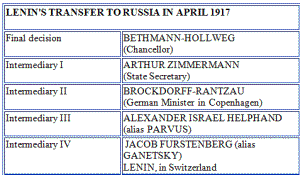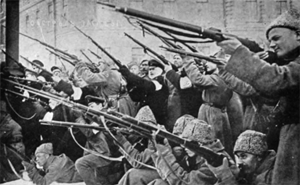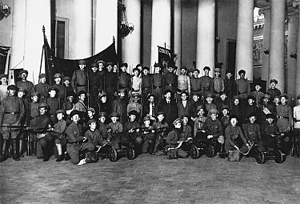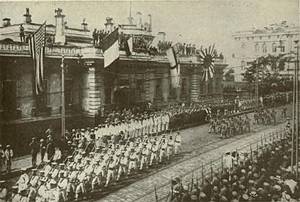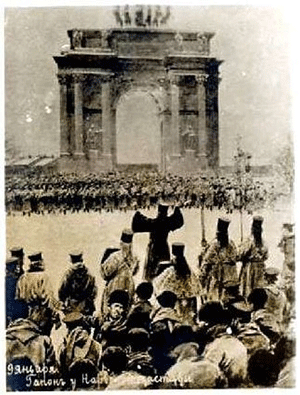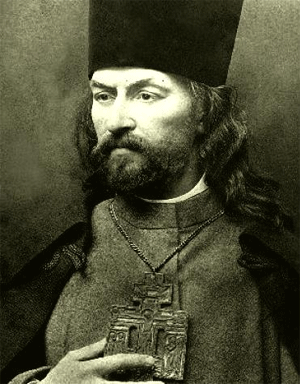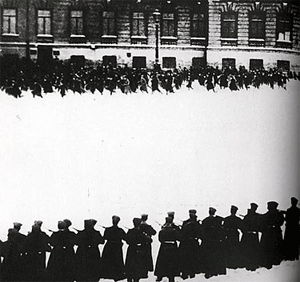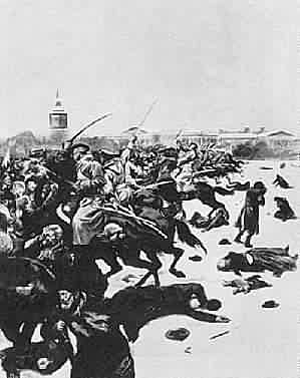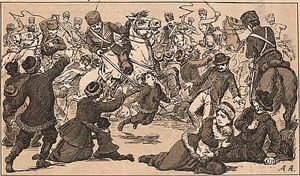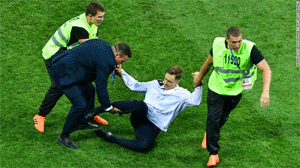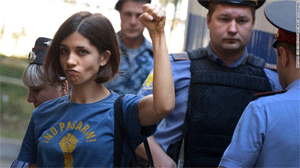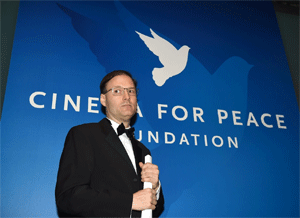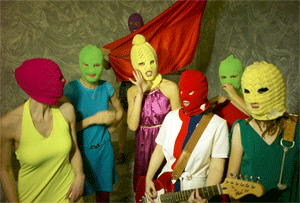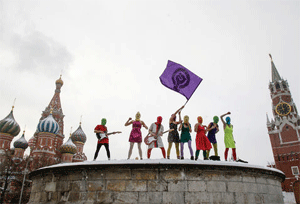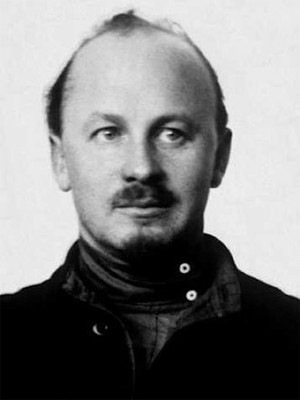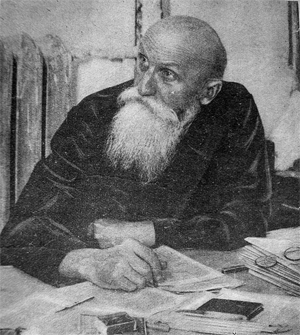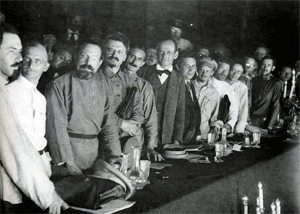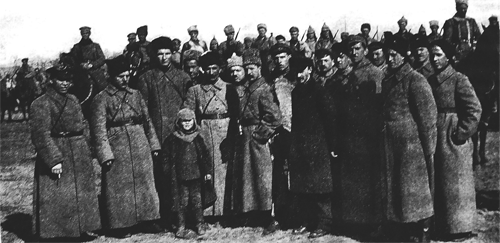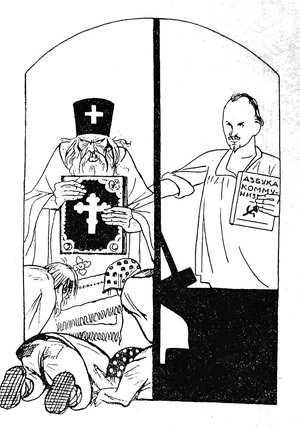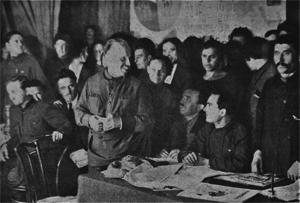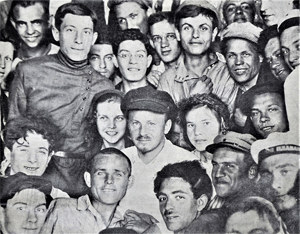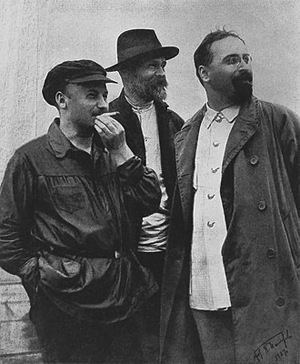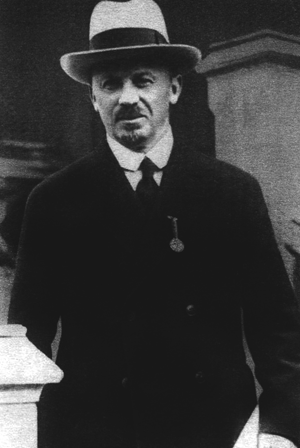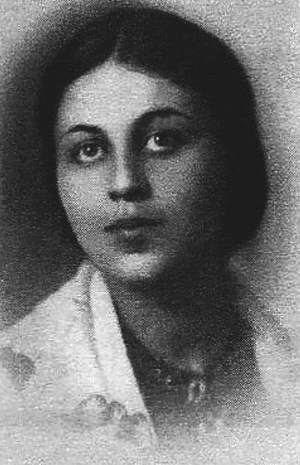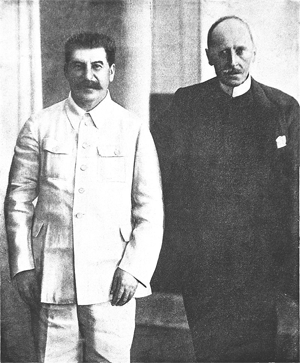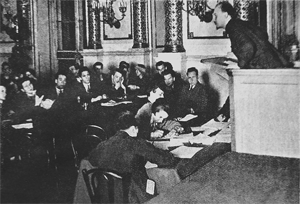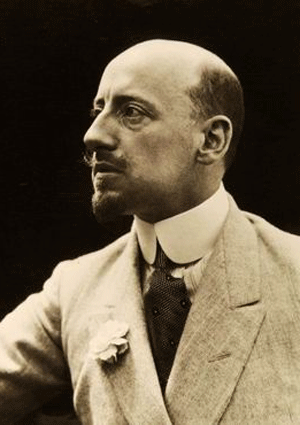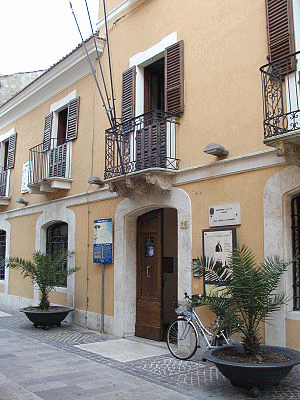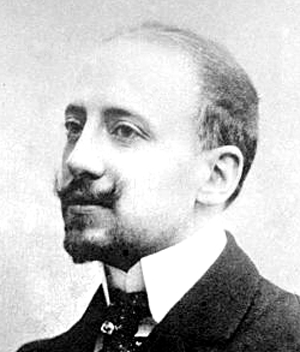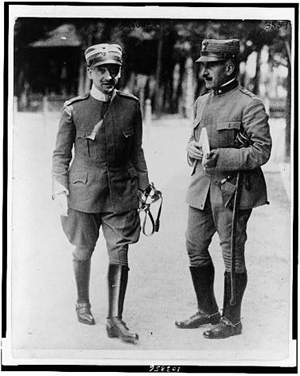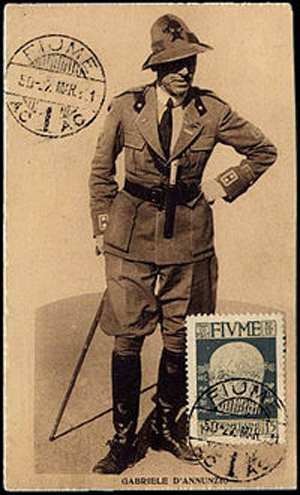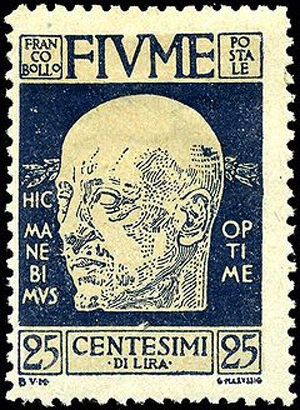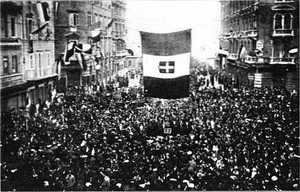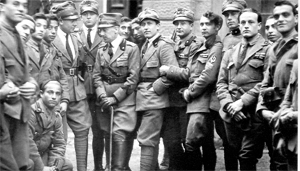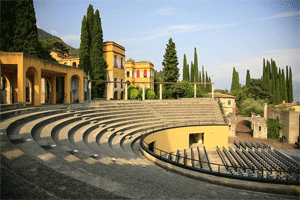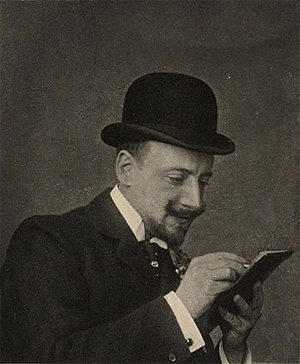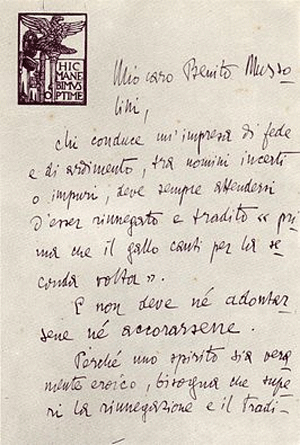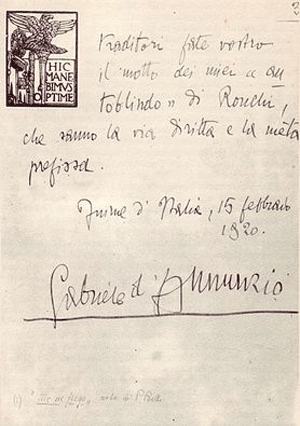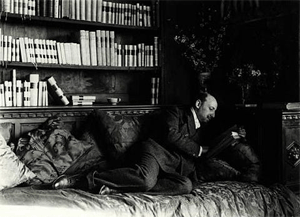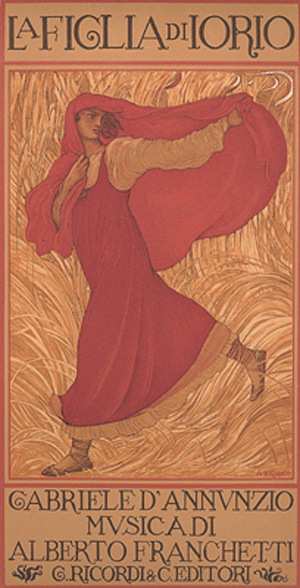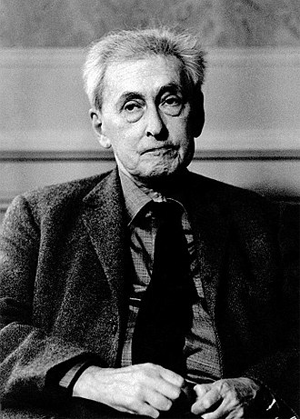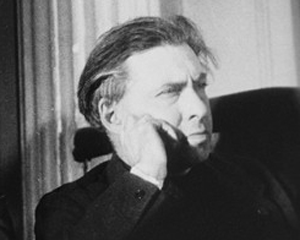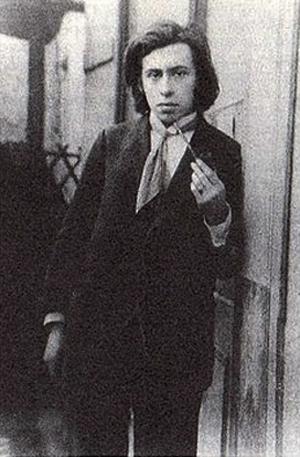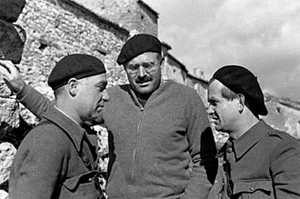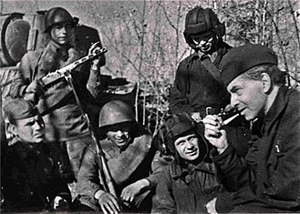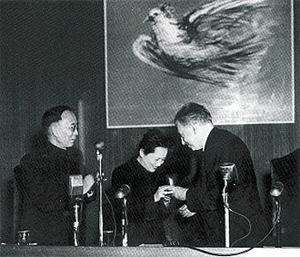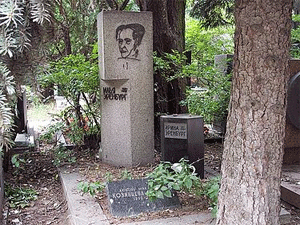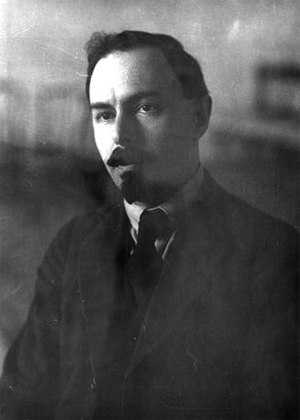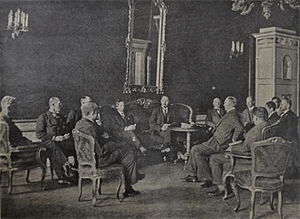Russian Revolution
by Wikipedia
Accessed: 9/3/18
NOTICE: THIS WORK MAY BE PROTECTED BY COPYRIGHT
YOU ARE REQUIRED TO READ THE COPYRIGHT NOTICE AT THIS LINK BEFORE YOU READ THE FOLLOWING WORK, THAT IS AVAILABLE SOLELY FOR PRIVATE STUDY, SCHOLARSHIP OR RESEARCH PURSUANT TO 17 U.S.C. SECTION 107 AND 108. IN THE EVENT THAT THE LIBRARY DETERMINES THAT UNLAWFUL COPYING OF THIS WORK HAS OCCURRED, THE LIBRARY HAS THE RIGHT TO BLOCK THE I.P. ADDRESS AT WHICH THE UNLAWFUL COPYING APPEARED TO HAVE OCCURRED. THANK YOU FOR RESPECTING THE RIGHTS OF COPYRIGHT OWNERS.
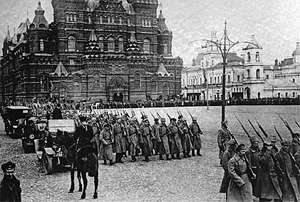
Bolshevik forces marching on the Red Square
Date February Revolution:
8 – 16 March 1917
(O.S. 23 February – 3 March)
October Revolution:
7 – 8 November 1917
(O.S. 25 – 26 October)
Location Russian Empire
Participants Russian society, bolsheviks, mensheviks, SRs, etc.
Outcome
Abdication of Nicholas II
Collapse of the Imperial Government
Collapse of the Provisional Government
Creation of the Russian SFSR
Beginning of the Russian Civil War
The Russian Revolution was a pair of revolutions in Russia in 1917 which dismantled the Tsarist autocracy and led to the rise of the Soviet Union. The Russian Empire collapsed with the abdication of Emperor Nicholas II and the old regime was replaced by a provisional government during the first revolution of February 1917 (March in the Gregorian calendar; the older Julian calendar was in use in Russia at the time). Alongside it arose grassroots community assemblies (called 'soviets') which contended for authority. In the second revolution that October, the Provisional Government was toppled and all power was given to the soviets.
The February Revolution (March 1917) was a revolution focused around Petrograd (now Saint Petersburg), the capital of Russia at that time. In the chaos, members of the Imperial parliament (the Duma) assumed control of the country, forming the Russian Provisional Government which was heavily dominated by the interests of large capitalists and the noble aristocracy. The army leadership felt they did not have the means to suppress the revolution, resulting in Nicholas's abdication. The soviets, which were dominated by soldiers and the urban industrial working class, initially permitted the Provisional Government to rule, but insisted on a prerogative to influence the government and control various militias. The February Revolution took place in the context of heavy military setbacks during the First World War (1914–18), which left much of the Russian Army in a state of mutiny.
A period of dual power ensued, during which the Provisional Government held state power while the national network of soviets, led by socialists, had the allegiance of the lower classes and, increasingly, the left-leaning urban middle class. During this chaotic period there were frequent mutinies, protests and many strikes. Many socialist political organizations were engaged in daily struggle and vied for influence within the Duma and the soviets, central among which were the Bolsheviks ("Ones of the Majority") led by Vladimir Lenin who campaigned for an immediate end to the war, land to the peasants, and bread to the workers. When the Provisional Government chose to continue fighting the war with Germany, the Bolsheviks and other socialist factions were able to exploit virtually universal disdain towards the war effort as justification to advance the revolution further. The Bolsheviks turned workers' militias under their control into the Red Guards (later the Red Army) over which they exerted substantial control.[1]
In the October Revolution (November in the Gregorian calendar), the Bolsheviks led an armed insurrection by workers and soldiers in Petrograd that successfully overthrew the Provisional Government, transferring all its authority to the soviets with the capital being relocated to Moscow shortly thereafter. The Bolsheviks had secured a strong base of support within the soviets and, as the now supreme governing party, established a federal government dedicated to reorganizing the former empire into the world's first socialist republic, practicing soviet democracy on a national and international scale. The promise to end Russia's participation in the First World War was honored promptly with the Bolshevik leaders signing the Treaty of Brest-Litovsk with Germany in March 1918. To further secure the new state, the Cheka was established which functioned as a revolutionary security service that sought to weed out and punish those considered to be "enemies of the people" in campaigns consciously modeled on similar events during the French Revolution.
Soon after, civil war erupted among the "Reds" (Bolsheviks), the "Whites" (counter-revolutionaries), the independence movements and the non-Bolshevik socialists. It continued for several years, during which the Bolsheviks defeated both the Whites and all rival socialists and thereafter reconstituted themselves as the Communist Party. In this way, the Revolution paved the way for the creation of the Union of Soviet Socialist Republics (USSR) in 1922. While many notable historical events occurred in Moscow and Petrograd, there was also a visible movement in cities throughout the state, among national minorities throughout the empire and in the rural areas, where peasants took over and redistributed land.
Background
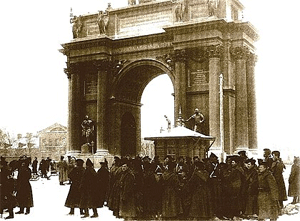
Soldiers blocking Narva Gate on Bloody Sunday
The Russian Revolution of 1905 was said to be a major factor contributing to the cause of the Revolutions of 1917. The events of Bloody Sunday triggered nationwide protests and soldier mutinies. A council of workers called the St. Petersburg Soviet was created in this chaos.[2] While the 1905 Revolution was ultimately crushed, and the leaders of the St. Petersburg Soviet were arrested, this laid the groundwork for the later Petrograd Soviet and other revolutionary movements during the leadup to 1917. The 1905 Revolution also led to the creation of a Duma (parliament), that would later form the Provisional Government following February 1917.[3]
The outbreak of World War I prompted general outcry directed at Tsar Nicholas II and the Romanov family. While the nation was initially caught up in a wave of nationalism, increasing numbers of defeats and poor conditions soon made the opposite true. The Tsar attempted to remedy the situation by taking personal control of the army in 1915. This proved disastrous, as the Tsar was now held personally responsible for Russia's continuing defeats and losses. In addition, the Tsarina Alexandra, left to rule in while the Tsar was commanding at the front, was German born, leading to suspicion of collusion, only exacerbated by rumors relating to her relationship with the controversial mystic Rasputin. Rasputin's influence led to disastrous ministerial appointments and corruption, resulting in a worsening of conditions within Russia. This led to general dissatisfaction with the Romanov family, and was a major factor contributing to the retaliation of the Russian Communists against the royal family.[3]
After the entry of the Ottoman Empire on the side of the Central Powers in October 1914, Russia was deprived of a major trade route through the Dardanelles, which further contributed to the economic crisis, in which Russia became incapable of providing munitions to their army in the years leading to 1917. However, the problems were primarily administrative, and not industrial, as Germany was producing great amounts of munitions whilst constantly fighting on two major battlefronts.[4]
The conditions during the war resulted in devastating loss of morale within the Russian army, as well as the general population. This was particularly apparent in the cities, owing to a lack of food in response to the disruption of agriculture. Food scarcity had become a considerable problem in Russia, but the cause of this did not lie in any failure of the harvests, which had not been significantly altered during wartime. The indirect reason was that the government, in order to finance the war, had been printing millions of ruble notes, and by 1917 inflation had made prices increase up to four times what they had been in 1914. Farmers were consequently faced with a higher cost of living, but little increase in income. As a result, they tended to hoard their grain and to revert to subsistence farming. Thus the cities were constantly short of food. At the same time, rising prices led to demands for higher wages in the factories, and in January and February 1916 revolutionary propaganda, in part aided by German funds, led to widespread strikes. This resulted in a growing criticism of the government, including an increased participation of workers in revolutionary parties.
Liberal parties too had an increased platform to voice their complaints, as the initial fervor of the war had resulted in the Tsarist government creating a variety of political organizations. In July 1915, a Central War Industries Committee was established under the chairmanship of a prominent Octobrist, Alexander Guchkov (1862-1936), including ten workers' representatives. The Petrograd Mensheviks agreed to join despite the objections of their leaders abroad. All this activity gave renewed encouragement to political ambitions, and, in September 1915, a combination of Octobrists and Kadets in the Duma demanded the forming of a responsible government. The Tsar rejected these proposals.[5]
All these factors had given rise to a sharp loss of confidence in the regime, even within the ruling class, growing throughout the war. Early in 1916, Guchkov discussed with senior army officers and members of the Central War Industries Committee about a possible coup to force the abdication of the Tsar. In December, a small group of nobles assassinated Rasputin, and in January 1917 the Tsar's uncle, Grand Duke Nicholas, was asked indirectly by Prince Lvov whether he would be prepared to take over the throne from his nephew, Tsar Nicholas II. None of these incidents were in themselves the immediate cause of the February Revolution, but they do help to explain why the monarchy survived only a few days after it had broken out.[5]
Meanwhile, Socialist Revolutionary leaders in exile, many of them living in Switzerland, had been the glum spectators of the collapse of international socialist solidarity. French and German Social Democrats had voted in favour of their respective governments' war efforts. Georgi Plekhanov in Paris had adopted a violently anti-German stand, while Parvus supported the German war effort as the best means of ensuring a revolution in Russia. The Mensheviks largely maintained that Russia had the right to defend herself against Germany, although Martov (a prominent Menshevik), now on the left of his group, demanded an end to the war and a settlement on the basis of national self-determination, with no annexations or indemnities.[5]
It was these views of Martov that predominated in a manifesto drawn up by Leon Trotsky (at the time a Menshevik) at a conference in Zimmerwald, attended by 35 Socialist leaders in September 1915. Inevitably Vladimir Lenin, supported by Zinoviev and Radek, strongly contested them. Their attitudes became known as the Zimmerwald Left. Lenin rejected both the defence of Russia and the cry for peace. Since the autumn of 1914, he had insisted that "from the standpoint of the working class and of the labouring masses from the lesser evil would be the defeat of the Tsarist Monarchy"; the war must be turned into a civil war of the proletarian soldiers against their own governments, and if a proletarian victory should emerge from this in Russia, then their duty would be to wage a revolutionary war for the liberation of the masses throughout Europe.[6]
Economic and social changes
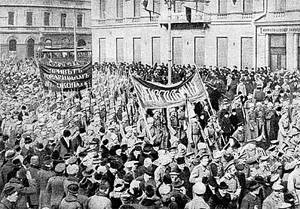
Russian soldiers marching in Petrograd in February 1917
An elementary theory of property, believed by many peasants, was that land should belong to those who work on it. At the same time, peasant life and culture was changing constantly. Change was facilitated by the physical movement of growing numbers of peasant villagers who migrated to and from industrial and urban environments, but also by the introduction of city culture into the village through material goods, the press, and word of mouth.[nb 1]
Workers also had good reasons for discontent: overcrowded housing with often deplorable sanitary conditions, long hours at work (on the eve of the war a 10-hour workday six days a week was the average and many were working 11–12 hours a day by 1916), constant risk of injury and death from poor safety and sanitary conditions, harsh discipline (not only rules and fines, but foremen's fists), and inadequate wages (made worse after 1914 by steep wartime increases in the cost of living). At the same time, urban industrial life was full of benefits, though these could be just as dangerous, from the point of view of social and political stability, as the hardships. There were many encouragements to expect more from life. Acquiring new skills gave many workers a sense of self-respect and confidence, heightening expectations and desires. Living in cities, workers encountered material goods such as they had never seen in villages. Most important, living in cities, they were exposed to new ideas about the social and political order.[nb 2]
The social causes of the Russian Revolution mainly came from centuries of oppression of the lower classes by the Tsarist regime, and Nicholas's failures in World War I. While rural agrarian peasants had been emancipated from serfdom in 1861, they still resented paying redemption payments to the state, and demanded communal tender of the land they worked. The problem was further compounded by the failure of Sergei Witte's land reforms of the early 20th century. Increasing peasant disturbances and sometimes actual revolts occurred, with the goal of securing ownership of the land they worked. Russia consisted mainly of poor farming peasants, with 1.5% of the population owning 25% of the land.
The rapid industrialization of Russia also resulted in urban overcrowding and poor conditions for urban industrial workers (as mentioned above). Between 1890 and 1910, the population of the capital, Saint Petersburg, swelled from 1,033,600 to 1,905,600, with Moscow experiencing similar growth. This created a new 'proletariat' which, due to being crowded together in the cities, was much more likely to protest and go on strike than the peasantry had been in previous times. In one 1904 survey, it was found that an average of sixteen people shared each apartment in Saint Petersburg, with six people per room. There was also no running water, and piles of human waste were a threat to the health of the workers. The poor conditions only aggravated the situation, with the number of strikes and incidents of public disorder rapidly increasing in the years shortly before World War I. Because of late industrialization, Russia's workers were highly concentrated. By 1914, 40% of Russian workers were employed in factories of 1,000+ workers (32% in 1901). 42% worked in 100–1,000 worker enterprises, 18% in 1–100 worker businesses (in the US, 1914, the figures were 18, 47 and 35 respectively).[7]
Years / Average annual strikes[8]
1862–69 / 6
1870–84 / 20
1885–94 / 33
1895–1905 / 176
World War I added to the chaos. Conscription swept up the unwilling across Russia. The vast demand for factory production of war supplies and workers caused many more labor riots and strikes. Conscription stripped skilled workers from the cities, who had to be replaced with unskilled peasants, and then, when famine began to hit due to the poor railway system, workers abandoned the cities in droves seeking food. Finally, the soldiers themselves, who suffered from a lack of equipment and protection from the elements, began to turn against the Tsar. This was mainly because, as the war progressed, many of the officers who were loyal to the Tsar were killed, and were replaced by discontented conscripts from the major cities, who had little loyalty to the Tsar.
Political issues

The Petrograd Soviet Assembly meeting in 1917
Many sections of the country had reason to be dissatisfied with the existing autocracy. Nicholas II was a deeply conservative ruler and maintained a strict authoritarian system. Individuals and society in general were expected to show self-restraint, devotion to community, deference to the social hierarchy and a sense of duty to the country. Religious faith helped bind all of these tenets together as a source of comfort and reassurance in the face of difficult conditions and as a means of political authority exercised through the clergy. Perhaps more than any other modern monarch, Nicholas II attached his fate and the future of his dynasty to the notion of the ruler as a saintly and infallible father to his people.[nb 3]
This idealized vision of the Romanov monarchy blinded him to the actual state of his country. With a firm belief that his power to rule was granted by Divine Right, Nicholas assumed that the Russian people were devoted to him with unquestioning loyalty. This ironclad belief rendered Nicholas unwilling to allow the progressive reforms that might have alleviated the suffering of the Russian people. Even after the 1905 revolution spurred the Tsar to decree limited civil rights and democratic representation, he worked to limit even these liberties in order to preserve the ultimate authority of the crown.[nb 3]
Despite constant oppression, the desire of the people for democratic participation in government decisions was strong. Since the Age of Enlightenment, Russian intellectuals had promoted Enlightenment ideals such as the dignity of the individual and the rectitude of democratic representation. These ideals were championed most vociferously by Russia's liberals, although populists, Marxists, and anarchists also claimed to support democratic reforms. A growing opposition movement had begun to challenge the Romanov monarchy openly well before the turmoil of World War I.
Dissatisfaction with Russian autocracy culminated in the huge national upheaval that followed the Bloody Sunday massacre of January 1905, in which hundreds of unarmed protesters were shot by the Tsar's troops. Workers responded to the massacre with a crippling general strike, forcing Nicholas to put forth the October Manifesto, which established a democratically elected parliament (the State Duma). The Tsar undermined this promise of reform but a year later with Article 87 of the 1906 Fundamental State Laws, and subsequently dismissed the first two Dumas when they proved uncooperative. Unfulfilled hopes of democracy fueled revolutionary ideas and violent outbursts targeted at the monarchy.
One of the Tsar's principal rationales for risking war in 1914 was his desire to restore the prestige that Russia had lost amid the debacles of the Russo-Japanese war. Nicholas also sought to foster a greater sense of national unity with a war against a common and ancient enemy.
The Russian Empire was an agglomeration of diverse ethnicities that had shown significant signs of disunity in the years before the First World War. Nicholas believed in part that the shared peril and tribulation of a foreign war would mitigate the social unrest over the persistent issues of poverty, inequality, and inhuman working conditions. Instead of restoring Russia's political and military standing, World War I led to the horrifying slaughter of Russian troops and military defeats that undermined both the monarchy and society in general to the point of collapse.
World War I
The outbreak of war in August 1914 initially served to quiet the prevalent social and political protests, focusing hostilities against a common external enemy, but this patriotic unity did not last long. As the war dragged on inconclusively, war-weariness gradually took its toll. More important, though, was a deeper fragility: although many ordinary Russians joined anti-German demonstrations in the first few weeks of the war, the most widespread reaction appears to have been skepticism and fatalism. Hostility toward the Kaiser and the desire to defend their land and their lives did not necessarily translate into enthusiasm for the Tsar or the government.[9][10][11]
Russia's first major battle of the war was a disaster: in the 1914 Battle of Tannenberg, over 30,000 Russian troops were killed or wounded and 90,000 captured, while Germany suffered just 12,000 casualties.
The Battle of Tannenberg was fought between Russia and Germany between the 26th and 30th of August 1914, the first month of World War I. The battle resulted in the almost complete destruction of the Russian Second Army and the suicide of its commanding general, Alexander Samsonov. A series of follow-up battles (First Masurian Lakes) destroyed most of the First Army as well and kept the Russians off balance until the spring of 1915. The battle is particularly notable for fast rail movements by the Germans, enabling them to concentrate against each of the two Russian armies in turn, and also for the failure of the Russians to encode their radio messages. It brought considerable prestige to Field Marshal Paul von Hindenburg and his rising staff-officer Erich Ludendorff.
Although the battle actually took place near Allenstein (Olsztyn) [Poland], Hindenburg named it after Tannenberg, 30 km to the west, in order to, in German eyes, avenge the defeat of the Teutonic Knights 500 years earlier at the Battle of Grunwald (which was always known as the Battle of Tannenberg in German).
-- Battle of Tannenberg, by Wikipedia
The Battle of Grunwald, First Battle of Tannenberg or Battle of Žalgiris, was fought on 15 July 1410 during the Polish–Lithuanian–Teutonic War. The alliance of the Kingdom of Poland and the Grand Duchy of Lithuania, led respectively by King Władysław II Jagiełło (Jogaila) and Grand Duke Vytautas, decisively defeated the German–Prussian Teutonic Knights, led by Grand Master Ulrich von Jungingen. Most of the Teutonic Knights' leadership were killed or taken prisoner. Although defeated, the Teutonic Knights withstood the siege of their fortress in Marienburg (Malbork) and suffered minimal territorial losses at the Peace of Thorn (1411) (Toruń), with other territorial disputes continuing until the Peace of Melno in 1422. The knights, however, would never recover their former power, and the financial burden of war reparations caused internal conflicts and an economic downturn in the lands under their control. The battle shifted the balance of power in Central and Eastern Europe and marked the rise of the Polish–Lithuanian union as the dominant political and military force in the region.[8]
The battle was one of the largest in medieval Europe and is regarded as one of the most important victories in the histories of Poland and Lithuania and is also widely celebrated in Belarus.[9]
-- Battle of Grunwald, by Wikipedia
However, Austro-Hungarian forces allied to Germany were driven back deep into the Galicia region by the end of the year. In the autumn of 1915, Nicholas had taken direct command of the army, personally overseeing Russia's main theatre of war and leaving his ambitious but incapable wife Alexandra in charge of the government. Reports of corruption and incompetence in the Imperial government began to emerge, and the growing influence of Grigori Rasputin in the Imperial family was widely resented. In the eyes of Michael Lynch, a revisionist historian (member of the School of Historical Studies at the University of Leicester) who focuses on the role of the people, Rasputin was a "fatal disease" to the Tsarist regime.
In 1915, things took a critical turn for the worse when Germany shifted its focus of attack to the Eastern front. The superior German army – better led, better trained and better supplied – was terrifyingly effective against the ill-equipped Russian forces, driving the Russians out of Galicia, as well as Russian Poland, during the Gorlice–Tarnów Offensive campaign. By the end of October 1916, Russia had lost between 1,600,000 and 1,800,000 soldiers, with an additional 2,000,000 prisoners of war and 1,000,000 missing, all making up a total of nearly 5,000,000 men.
These staggering losses played a definite role in the mutinies and revolts that began to occur. In 1916, reports of fraternizing with the enemy started to circulate. Soldiers went hungry, and lacked shoes, munitions, and even weapons. Rampant discontent lowered morale, which was further undermined by a series of military defeats.
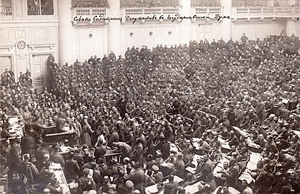
Russian troops awaiting German attack in trenches
Casualty rates were the most vivid sign of this disaster. Already, by the end of 1914, only five months into the war, around 390,000 Russian men had lost their lives and nearly 1,000,000 were injured. Far sooner than expected, barely trained recruits had to be called up for active duty, a process repeated throughout the war as staggering losses continued to mount. The officer class also saw remarkable changes, especially within the lower echelons, which were quickly filled with soldiers rising up through the ranks. These men, usually of peasant or working-class backgrounds, were to play a large role in the politicization of the troops in 1917.
The huge losses on the battlefields were not limited to men. The army quickly ran short of rifles and ammunition (as well as uniforms and food), and, by mid-1915, men were being sent to the front bearing no arms. It was hoped that they could equip themselves with the arms that they recovered from fallen soldiers, of both sides, on the battlefields. The soldiers did not feel that they were being treated as valuable soldiers, or even as human beings, but rather as raw materials to be squandered for the purposes of the rich and powerful.
By the spring of 1915, the army was in steady retreat, which was not always orderly; desertion, plunder and chaotic flight were not uncommon. By 1916, however, the situation had improved in many respects. Russian troops stopped retreating, and there were even some modest successes in the offensives that were staged that year, albeit at great loss of life. Also, the problem of shortages was largely solved by a major effort to increase domestic production. Nevertheless, by the end of 1916, morale among soldiers was even worse than it had been during the great retreat of 1915. The fortunes of war may have improved, but the fact of the war, still draining away strength and lives from the country and its many individuals and families, remained an oppressive inevitability. The crisis in morale (as was argued by Allan Wildman, a leading historian of the Russian army in war and revolution) "was rooted fundamentally in the feeling of utter despair that the slaughter would ever end and that anything resembling victory could be achieved."[12]
The war devastated not only soldiers. By the end of 1915, there were manifold signs that the economy was breaking down under the heightened strain of wartime demand. The main problems were food shortages and rising prices. Inflation dragged incomes down at an alarmingly rapid rate, and shortages made it difficult to buy even what one could afford. These shortages were a problem especially in the capital, St. Petersburg, where distance from supplies and poor transportation networks made matters particularly bad. Shops closed early or entirely for lack of bread, sugar, meat and other provisions, and lines lengthened massively for what remained. It became increasingly difficult both to afford and actually buy food.
Not surprisingly, strikes increased steadily from the middle of 1915, and so did crime; but, for the most part, people suffered and endured, scouring the city for food. Working class women in St. Petersburg reportedly spent about forty hours a week in food lines, begging, turning to prostitution or crime, tearing down wooden fences to keep stoves heated for warmth, grumbling about the rich, and wondering when and how this would all come to an end.
Government officials responsible for public order worried about how long people's patience would last. A report by the St. Petersburg branch of the security police, the Okhrana, in October 1916, warned bluntly of "the possibility in the near future of riots by the lower classes of the empire enraged by the burdens of daily existence."[13]
Nicholas was blamed for all of these crises, and what little support he had left began to crumble. As discontent grew, the State Duma issued a warning to Nicholas in November 1916. It stated that, inevitably, a terrible disaster would grip the country unless a constitutional form of government was put in place. Nicholas ignored these warnings and Russia's Tsarist regime collapsed a few months later during the February Revolution of 1917. One year later, the Tsar and his entire family were executed.
February Revolution
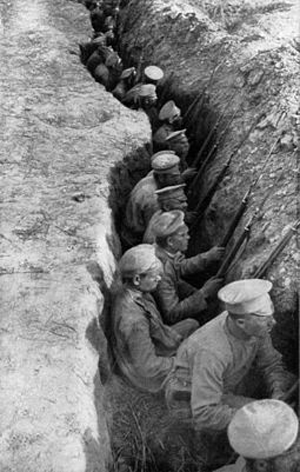
Revolutionaries protesting in February 1917
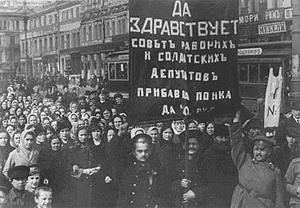
Meeting Germans in No Man's Land
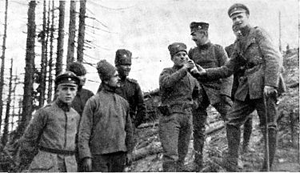
Meeting before the Russian wire entanglements
At the beginning of February, Petrograd workers began several strikes and demonstrations. On 7 March [O.S. 22 February], workers at Putilov, Petrograd's largest industrial plant, announced a strike.[14]
The next day, a series of meetings and rallies were held for International Women's Day, which gradually turned into economic and political gatherings. Demonstrations were organised to demand bread, and these were supported by the industrial working force who considered them a reason for continuing the strikes. The women workers marched to nearby factories bringing out over 50,000 workers on strike.[15] By 10 March [O.S. 25 February], virtually every industrial enterprise in Petrograd had been shut down, together with many commercial and service enterprises. Students, white-collar workers and teachers joined the workers in the streets and at public meetings.
To quell the riots, the Tsar looked to the army. At least 180,000 troops were available in the capital, but most were either untrained or injured. Historian Ian Beckett suggests around 12,000 could be regarded as reliable, but even these proved reluctant to move in on the crowd, since it included so many women. It was for this reason that when, on 11 March [O.S. 26 February], the Tsar ordered the army to suppress the rioting by force, troops began to mutiny.[16] Although few actively joined the rioting, many officers were either shot or went into hiding; the ability of the garrison to hold back the protests was all but nullified, symbols of the Tsarist regime were rapidly torn down around the city, and governmental authority in the capital collapsed – not helped by the fact that Nicholas had prorogued the Duma that morning, leaving it with no legal authority to act. The response of the Duma, urged on by the liberal bloc, was to establish a Temporary Committee to restore law and order; meanwhile, the socialist parties establish the Petrograd Soviet to represent workers and soldiers. The remaining loyal units switched allegiance the next day.[17]
The Tsar directed the royal train back towards Petrograd, which was stopped 14 March [O.S. 1 March],[16] by a group of revolutionaries at Malaya Vishera. When the Tsar finally arrived in Pskov, the Army Chief Nikolai Ruzsky, and the Duma deputees Guchkov and Vasily Shulgin suggested in unison that he abdicate the throne. He did so on 15 March [O.S. 2 March], on behalf of himself, and then, having taken advice, on behalf of his son, the Tsarevich.[16] Nicholas nominated his brother, the Grand Duke Michael Alexandrovich, to succeed him. But the Grand Duke realised that he would have little support as ruler, so he declined the crown on 16 March [O.S. 3 March],[16] stating that he would take it only if that was the consensus of democratic action.[18] Six days later, Nicholas, no longer Tsar and addressed with contempt by the sentries as "Nicholas Romanov", was reunited with his family at the Alexander Palace at Tsarskoye Selo.[19] He was placed under house arrest with his family by the Provisional Government.
The immediate effect of the February Revolution was a widespread atmosphere of elation and excitement in Petrograd.[20] On 16 March [O.S. 3 March], a provisional government was announced. The center-left was well represented, and the government was initially chaired by a liberal aristocrat, Prince Georgy Yevgenievich Lvov, a member of the Constitutional Democratic party (KD).[21] The socialists had formed their rival body, the Petrograd Soviet (or workers' council) four days earlier. The Petrograd Soviet and the Provisional Government competed for power over Russia.
Between February and throughout October: "Dual Power" (dvoevlastie)
The effective power of the Provisional Government was challenged by the authority of an institution that claimed to represent the will of workers and soldiers and could, in fact, mobilize and control these groups during the early months of the revolution – the Petrograd Soviet [Council] of Workers' Deputies. The model for the soviet were workers' councils that had been established in scores of Russian cities during the 1905 Revolution. In February 1917, striking workers elected deputies to represent them and socialist activists began organizing a citywide council to unite these deputies with representatives of the socialist parties. On 27 February, socialist Duma deputies, mainly Mensheviks and Socialist Revolutionaries, took the lead in organizing a citywide council. The Petrograd Soviet met in the Tauride Palace, the same building where the new government was taking shape.
The leaders of the Petrograd Soviet believed that they represented particular classes of the population, not the whole nation. They also believed Russia was not ready for socialism. So they saw their role as limited to pressuring hesitant "bourgeoisie" to rule and to introduce extensive democratic reforms in Russia (the replacement of the monarchy by a republic, guaranteed civil rights, a democratic police and army, abolition of religious and ethnic discrimination, preparation of elections to a constituent assembly, and so on).[22] They met in the same building as the emerging Provisional Government not to compete with the Duma Committee for state power but to best exert pressure on the new government, to act, in other words, as a popular democratic lobby.
The relationship between these two major powers was complex from the beginning and would shape the politics of 1917. The representatives of the Provisional Government agreed to "take into account the opinions of the Soviet of Workers' Deputies", though they were also determined to prevent "interference in the actions of the government", which would create "an unacceptable situation of dual power."[23] In fact, this was precisely what was being created, though this "dual power" (dvoevlastie) was the result less of the actions or attitudes of the leaders of these two institutions than of actions outside their control, especially the ongoing social movement taking place on the streets of Russia's cities, in factories and shops, in barracks and in the trenches, and in the villages.
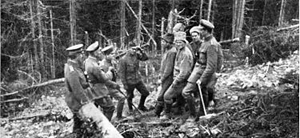
The 2nd Moscow Women Death Battalion protecting the Winter Palace as the last guards of the stronghold.
A series of political crises – see the chronology below – in the relationship between population and government and between the Provisional Government and the soviets (which developed into a nationwide movement with a national leadership, The All-Russian Central Executive Committee of Soviets (VTsIK)) undermined the authority of the Provisional Government but also of the moderate socialist leaders of the Soviet. Although the Soviet leadership initially refused to participate in the "bourgeois" Provisional Government, Alexander Kerensky, a young and popular lawyer and a member of the Socialist Revolutionary Party (SRP), agreed to join the new cabinet, and became an increasingly central figure in the government, eventually taking leadership of the Provisional Government. As minister of war and later Prime Minister, Kerensky promoted freedom of speech, released thousands of political prisoners, did his very best to continue the war effort and even organised another offensive (which, however, was no more successful than its predecessors). Nevertheless, Kerensky still faced several great challenges, highlighted by the soldiers, urban workers and peasants, who claimed that they had gained nothing by the revolution:
• Other political groups were trying to undermine him.
• Heavy military losses were being suffered on the front.
• The soldiers were dissatisfied and demoralised and had started to defect. (On arrival back in Russia, these soldiers were either imprisoned or sent straight back into the front.)
• There was enormous discontent with Russia's involvement in the war, and many were calling for an end to it.
• There were great shortages of food and supplies, which was difficult to remedy because of the wartime economic conditions.
The political group that proved most troublesome for Kerensky, and would eventually overthrow him, was the Bolshevik Party, led by Vladimir Lenin. Lenin had been living in exile in neutral Switzerland and, due to democratization of politics after the February Revolution, which legalized formerly banned political parties, he perceived the opportunity for his Marxist revolution. Although return to Russia had become a possibility, the war made it logistically difficult. Eventually, German officials arranged for Lenin to pass through their territory, hoping that his activities would weaken Russia or even – if the Bolsheviks came to power – led to Russia's withdrawal from the war. Lenin and his associates, however, had to agree to travel to Russia in a sealed train: Germany would not take the chance that he would foment revolution in Germany. After passing through the front, he arrived in Petrograd in April 1917.
On the way to Russia, Lenin prepared the April Theses, which outlined central Bolshevik policies. These included that the soviets take power (as seen in the slogan "all power to the soviets") and denouncing the liberals and social revolutionaries in the Provisional Government, forbidding co-operation with it. Many Bolsheviks, however, had supported the Provisional Government, including Lev Kamenev.[24]
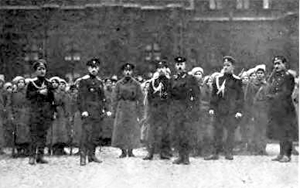
Street demonstration on Nevsky Prospekt in Petrograd just after troops of the Provisional Government opened fire in the July Days
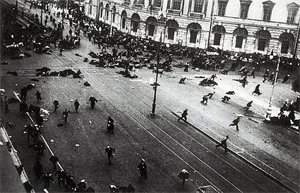
Soviets attacking the tsarist police in the early days of the March Revolution.
With Lenin's arrival, the popularity of the Bolsheviks increased steadily. Over the course of the spring, public dissatisfaction with the Provisional Government and the war, in particular among workers, soldiers and peasants, pushed these groups to radical parties. Despite growing support for the Bolsheviks, buoyed by maxims that called most famously for "all power to the Soviets," the party held very little real power in the moderate-dominated Petrograd Soviet. In fact, historians such as Sheila Fitzpatrick have asserted that Lenin's exhortations for the Soviet Council to take power were intended to arouse indignation both with the Provisional Government, whose policies were viewed as conservative, and the Soviet itself, which was viewed as subservient to the conservative government. By some historians' accounts, Lenin and his followers were unprepared for how their groundswell of support, especially among influential worker and soldier groups, would translate into real power in the summer of 1917.
On 18 June, the Provisional Government launched an attack against Germany that failed miserably. Soon after, the government ordered soldiers to go to the front, reneging on a promise. The soldiers refused to follow the new orders. The arrival of radical Kronstadt sailors – who had tried and executed many officers, including one admiral – further fueled the growing revolutionary atmosphere. The sailors and soldiers, along with Petrograd workers, took to the streets in violent protest, calling for "all power to the Soviets." The revolt, however, was disowned by Lenin[25] and the Bolshevik leaders and dissipated within a few days. In the aftermath, Lenin fled to Finland under threat of arrest while Trotsky, among other prominent Bolsheviks, was arrested. The July Days confirmed the popularity of the anti-war, radical Bolsheviks, but their unpreparedness at the moment of revolt was an embarrassing gaffe that lost them support among their main constituent groups: soldiers and workers.
The Bolshevik failure in the July Days proved temporary. The Bolsheviks had undergone a spectacular growth in membership. Whereas, in February 1917, the Bolsheviks were limited to only 24,000 members, by September 1917 there were 200,000 members of the Bolshevik faction.[26] Previously, the Bolsheviks had been in the minority in the two leading cities of Russia—St. Petersburg and Moscow behind the Mensheviks and the Socialist Revolutionaries, by September the Bolsheviks were in the majority in both cities.[27] Furthermore, the Bolshevik-controlled Moscow Regional Bureau of the Party also controlled the Party organizations of the thirteen (13) provinces around Moscow. These thirteen provinces held 37% of Russia's population and 20% of the membership of the Bolshevik faction.[27]
In August, poor or misleading communication led General Lavr Kornilov, the recently appointed Supreme Commander of Russian military forces, to believe that the Petrograd government had already been captured by radicals, or was in serious danger thereof. In response, he ordered troops to Petrograd to pacify the city. To secure his position, Kerensky had to ask for Bolshevik assistance. He also sought help from the Petrograd Soviet, which called upon armed Red Guards to "defend the revolution". The Kornilov Affair failed largely due to the efforts of the Bolsheviks, whose influence over railroad and telegraph workers proved vital in stopping the movement of troops. With his coup failing, Kornilov surrendered and was relieved of his position. The Bolsheviks' role in stopping the attempted coup further strengthened their position.
In early September, the Petrograd Soviet freed all jailed Bolsheviks and Trotsky became chairman of the Petrograd Soviet. Growing numbers of socialists and lower-class Russians viewed the government less and less as a force in support of their needs and interests. The Bolsheviks benefited as the only major organized opposition party that had refused to compromise with the Provisional Government, and they benefited from growing frustration and even disgust with other parties, such as the Mensheviks and Socialist Revolutionaries, who stubbornly refused to break with the idea of national unity across all classes.
In Finland, Lenin had worked on his book State and Revolution[28] and continued to lead his party, writing newspaper articles and policy decrees. By October, he returned to Petrograd (St. Petersburg), aware that the increasingly radical city presented him no legal danger and a second opportunity for revolution. Recognising the strength of the Bolsheviks, Lenin began pressing for the immediate overthrow of the Kerensky government by the Bolsheviks. Lenin was of the opinion that taking power should occur in both St. Petersburg and Moscow simultaneously, parenthetically stating that it made no difference which city rose up first, but expressing his opinion that Moscow may well rise up first.[29] The Bolshevik Central Committee drafted a resolution, calling for the dissolution of the Provisional Government in favor of the Petrograd Soviet. The resolution was passed 10–2 (Lev Kamenev and Grigory Zinoviev prominently dissenting) and the October Revolution began.

